Empires of Mesopotamia:
Akkadian Empire (ca. 2300 - 2200 BC)
Main Page: Akkadian Empire (2300-2200 BC)
Topics


Empires of Mesopotamia:
Akkadian Empire (ca. 2300 - 2200 BC)
Main Page: Akkadian Empire (2300-2200 BC)
Topics
Sargon of Akkad
Sargon’s Rise to Power
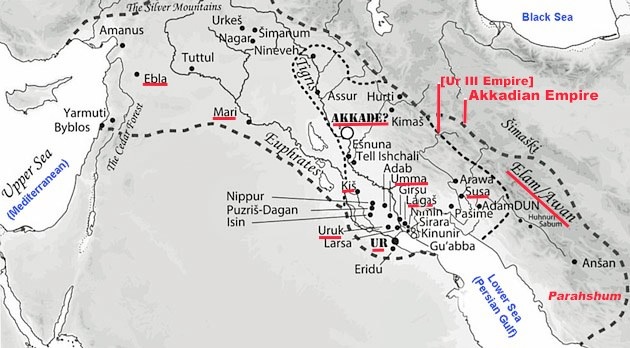
Image adapted from Piotr Steinkeller (referenced below, 2021, Map 2.1, at p. 69)
My additions: text in red and blue
As Piotr Steinkeller (referenced below, 2021, at p. 44) observed, the creation of the so-called Akkadian or Sargonic Empire by Sargon of Akkad (= Agade or Akkade):
“... was a completely novel experiment in the use of political power.”
Not least among the novel features of this ‘empire’ were the facts that:
✴the political power in question was passed down by dynastic succession, over a period of about a century, from Sargon to his great grandson, Shar-kali-sharri; and
✴at the height of their power, the dynastic kings of Akkad controlled the vast territory marked out in the map above.
Nevertheless (as the sharp-eyed will have noticed) Sargon’s capital is marked on the map as ‘Akkade ?’, since no archeological remains of this much-documented city have ever been found.
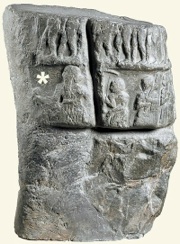
Victory stele of Sargon from Susa (now in the Musée du Louvre, Sb. 1)
Image from museum website: asterisk marks the figure of Sargon, identified by inscription
Furthermore, only two (fragmentary) royal inscriptions of Sargon survive in their original state:
✴an inscription (RIME 2:1:1:10, P461936, illustrated above) on the reverse of a victory stele from Susa names ‘Sargon, the king ....’; and
✴a fragmentary inscription (RIME 2:1:1:4, P217324) on a mace head from Ur (now in the Penn Museum: CBS 14396), which describes a now-unnamed king as the ‘conqueror of Uruk and U[r]’, can probably be assigned to Sargon on the basis of an Old Babylonian copy (RIME 2:1:1:5, P461930) from Nippur that records ‘Sargon, king of Akkad, conqueror of Uruk [and Ur].

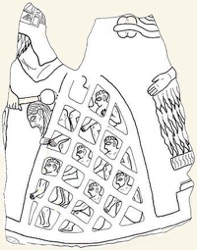
Right: Fragment of a stele of a now-unnamed king (probably Sargon0 from Susa:
now in the Musée du Louvre (Sb. 2): image from museum website
Left: sketch of the relief from Lorenzo Nigro (referenced below, Figure 1, at p. 86), who identified the king on the left
as Sargon, clubbing the head of the captive Lugal-zagesi of Uruk and the goddess on the right as Inanna/Ishtar
Finally, the fragment above, which was found near stele (Sb. 1) at Susa, probably depicted Sargon after his victory over Lugal-zagesi of Uruk (see below). The fragmentary inscription (RIME 2.0.0.1002, P461912) contains part of a curse:
“... (may the gods ...) and Ilaba(tear out) his foundations.”
Apart from these ‘original’ inscriptions, the earliest surviving reference to Sargon is on the earliest known recension of the so-called Sumerian King List, which dates to the reign of the ‘Ur III’ king Shulgi (hereafter the USKL, transliterated at CDLI: P283804: ca. 2050 BC), which was published by Piotr Steinkeller (referenced below, 2003 - see my page on the USKL): in this inscription, after a long lacuna, we read that:
“Sargon, in Akkad, [ruled for] 40 years”, (reverse col. 1, lines 6’-7’ in the CDLI transliteration).
Unfortunately, we do not know how Sargon was introduced in the preceding (now-lost) USKL text. However, in the later Old Babylonian recensions of the Sumerian King List (hereafter the SKL), which were compiled after the fall of Ur during the period of the Isin kings, we read that:
“Sargon, whose father was a gardener, the cupbearer of (king) Ur-Zababa, the king of Akkad, the one who built Akkad, was king [there: he] ruled for 56 years”, (SKL 266-271).
I discuss the historical value of this relatively late biographical note below.
We are thus reliant for most of what we ‘know’’about Sargon’ career on copies of his royal inscriptions from the Old Babylonian period, augmented by various literary texts, the historical value of which is usually uncertain.
Sargon’s ‘Victory’ Inscriptions
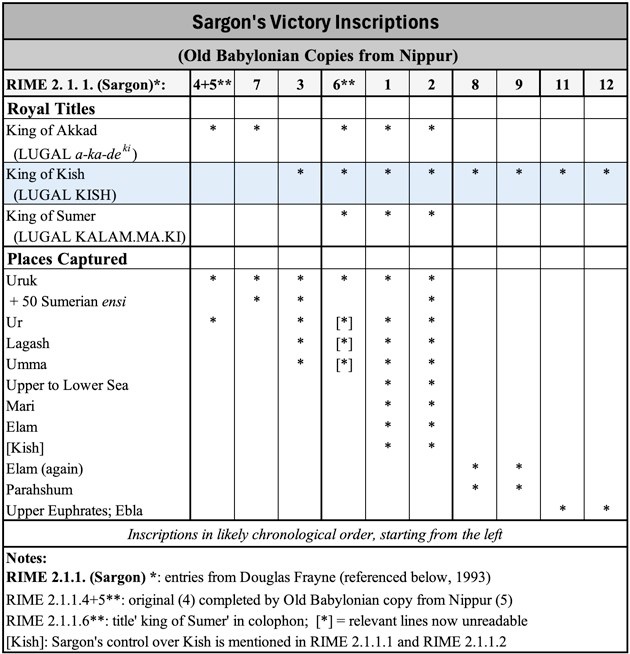
Douglas Frayne (referenced below, 1993, at p. 7) pointed out that, although very few of Sargon’s royal inscriptions survive in their original form:
“... a sizeable number [of them are] known from later Old Babylonian tablet copies: [in particular], two large Sammeltafeln [compilations of such copies] from Nippur:
✴one, [now] in Philadelphia (CBS 13972); [and]
✴the other, [now] in Istanbul (Ni 3200);
contain copies of several Sargon inscriptions. ... The originals of these copies may have been inscribed on triumphal steles that once stood in the courtyard of Enlil's Ekur temple in Nippur.”
He also observed (at p. 3) that:
“The Sargonic period marks the first time the Akkadian language was extensively used for royal inscriptions [in Sumer]. The majority of Sargon’s inscriptions are recorded in that language, [although] a minority are known in bilingual (Sumerian and Akkadian) versions, and a handful are in Sumerian alone.”
In the table above, I have summarised the contents of 10 of Sargon’s surviving ‘victory’ inscriptions (all of which except RIME 2.1.1.4, discussed above) are known from the Nippur Sammeltafeln: I have arranged them in the order suggested by the conquests to which they refer (in the hope that this roughly corresponds to their chronological order). It seems to me that the events described in these inscriptions probably fit into three chronological periods:
✴an early period, at around the time of Sargon’s conquest to Uruk and the rest of Sumer, when he used the title king of Akkad or king of Kish;
✴an intermediate period, in which he conquered Elam, Mari and other territory from the Upper to the Lower Sea, when he used three titles: king of Akkad; king of Kish; and king of Sumer; and
✴a later period, in which he consolidated his hold over Elam and extended his area of control to include Ebla to the north west and Parahshum to the south east, when he again used a single title, ‘LUGAL KISH’ (king of Kish).
I discuss this suggestion further in the following section, in the context of Sargon’s conquest of Kish. However, I will begin with an analysis of what is known about the evolution of hegemonic tendencies of Mesopotamian rulers before Sargon’s conquest of Kish.
Empire Building in Sumer (ca. 2400 BC)
Eanatum, Ensi of Lagash, King of Kish
Eanatum Boulder
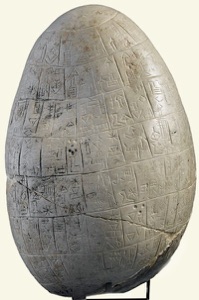
Eanatum Boulder, from Girsu (now in the Musée du Louvre: AO 2677: images from the museum website)
This section begins with Eanatum (who was already mentioned above) because he is the first ruler of a Sumerian city who is known to have adopted the additional title of ‘king of Kish’. The evidence for this ‘dual use’ of royal titles is from an inscription on the so-called ‘Eanatum Boulder’ (illustrated above):
“Because Inanna so loved Eanatum, ensi (ruler) of Lagash, she gave him nam-luga[ (the kingship) of Kish, together with nam-ensi2 (the rulership) of Lagash”, (RIME 1.9.3.5, P431079, lines 98-106).
In order to analyse the precise significance of this passage, it is first necessary to consider the structure of this inscription alongside that of another (RIME 1.9.3.6, P431080) to which it is closely related. As Jerrold Cooper, referenced below, at p 25) pointed out, each of these inscriptions is known from two examples, and all four of these examples begin with essentially the same text: after a long list of Eanatum’s gods and a short list of his construction projects, we read that:
“Eanatum defeated:
✴Elam, the amazing mountain, and made burial mounds for [its dead];
✴the ruler of Uru, who stood with the city's standard before him, and made burial mounds for [his dead];
✴Umma, and made 20 burial mounds for [its dead, thereby restoring] to Ningirsu the control his beloved field, the Gu'edena; and
✴Uruk, Ur, Kiutu and Iriaz ...
He raided Mishime and obliterated Arua. All the lands tremble before Eanatum, the one named by Ningirsu. When the king of Akshak attacked (him), Eanatum ... beat back Zuzu, king of Akshak, from the Antasura of Ningirsu ... and destroyed it (= Akshak)”, (see, for example, RIME 1.9.3.5, P431079, lines 1-85).
Jerrold Cooper, referenced below, at p 25 and notes 6-8) reasonably assumed that the overlapping text of RIME 1.9.3.5 and 1.9.3.6 constituted a basic account of Eanatum’s many victories, which was used (in part or in whole) in a number of his other inscriptions.
In the case of the ‘Eanatum Boulder’, this ‘standard text’ formed a preface to a second text that is otherwise unknown. It begins (at P431079, lines 91-4) with an account of Eanatum’s digging of the Lumma-gimdu canal ‘for Ningirsu’, and it might well have been commissioned to celebrate this event. It continues as follows:
“Because Inanna so loved Eanatum, the ensi (ruler) of Lagash, she gave him nam-luga[ (the kingship) of Kish, together with nam-ensi2 (the rulership) of Lagash:
✴Elam trembled before him (and) he sent the Elamite back to his land.
✴Kish trembled before him.
✴He sent the king of Akshak back to his land.
Eanatum, the ruler of Lagash, who subjugates foreign lands for Ningirsu, defeated:
✴Elam, Subartu and Uru at the Asuhur [canal (?) ... ; and]
✴Kish, Akshak and Mari at the Antasura of Ningirsu”, (RIME 1.9.3.5, P431079, lines 98-126).
Interestingly, Eanatum’s victories over Kish, Subartu and Mari are new additions to his ‘victory list’. It is hard to avoid the conclusion that there is a causal connection between the ‘facts’ that:
✴Kish ‘trembled before’ Eanatum; and
✴Inanna, who loved him, ‘gave him the kingship of Kish’.
Stele of the Vultures
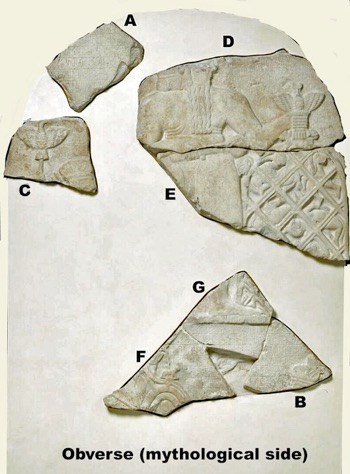
Surviving fragments from the ‘Stele of the Vultures’ (as seen on the obverse) from Girsu,
now in the Musée du Louvre (AO 50): images from the museum website (my additions in black)
To take this further, we should look at another important victory monument of Eanatum, usually referred to as the ‘Stele of the Vultures’ (illustrated above), which is known from seven fragments (A-G) of what was originally a huge limestone stele (exhibited in the Musée du Louvre as AO 50):
✴fragments A-C were excavated at the site of the Temple of Ningirsu at Girsu; and
✴fragment G, which clearly belonged to this stele, subsequently emerged in London and was re-united with the other fragments in Paris.
All of these fragments carry reliefs and inscriptions (RIME 1.9.3.1, P431075) on both sides. As Renate Marian van Dijk-Coombes (referenced below, at pp. 198-9) observed, when these fragments were laid out in what would have been their respective positions, it became obvious that the stele had what might be dubbed:
✴a historical side that is divided into four registers, in which the reliefs illustrate a battle between humans and its aftermath; and
✴a mythological side (see the illustration above) that is divided into two registers , in which the reliefs depict the imagined actions of the two deities thereafter.
The stele owes its modern name to the relief on the reverse of Fragment A, which depicts a flock of vultures carrying off the remains of fallen enemy soldiers (which would have represented the final scene in the ‘historical’ sequence). The inscription gives the original title in its closing lines:
“... its name is not that of a man: rather its name says:
‘Ningirsu, the Lord, the Crown of Lumma, is the Life of the Lion of the pirig-edin-na (Plain Canal),’
He, [Eanatum], erected for Ningirsu the stele of the Gu'edena , his beloved field, which Eanatum to Ningirsu had returned to him”, (lines 615’-629’);
and the inscription on each of the vertical edges identify:
“Eanatum, kur gu2 gar-gar (the subjugator of the lands of Ningirsu.”, (lines 630’-632’ and 633’-635’).
As we saw above, the text on a number of Eanatum’s other inscriptions (including the ‘Eanatum Boulder’) also recorded that Eanatum had repelled at least one incursion from Umma in order to return to Ningursu his ‘beloved field’, the Gu'edena. However, the surviving text on the ‘Stele of the Vultures’ adds to our understanding of these events (at least as interpreted by Eanatum). As Jerrold Cooper (referenced below, at p.26) observed, although much of the original text on the stele is now lost, the surviving account of the events leading up to the battle in which Eanatum ‘liberated’ the Gu'edena is:
“... well preserved and rather remarkable”.
After an initial, now-lacunose passage, we read that, in the reign of Akurgal, Eanatum’s father, the ensi of Umma, marched on Lagash, at which point:
“... Ningirsu, warrior of Enlil, ... implanted the semen for Eanatum in the womb ... [and] rejoiced over him.
✴Inanna took a place at his side and named him ‘[the one who is] fitting for the Eanna of Inanna of the Ibgal’
✴Ninhursaga, took him on her right knee and gave her right breast to him.
✴Ningirsu rejoiced over Eanatum, the one whose semen ... laid his ... [gigantic hand] upon him.
Ningirsu, with great joy, [granted Eanatum] nam-lugal (the kingship) of Lagash”, (RIME 1.9.3.1, P431075, lines 40’-82’).
In short, ‘cometh the moment. cometh the king’.
After Eanatum publicly curses the ruler of Umma, Ningirsu appears to him in a dream:
“As Eanatum lay sleeping, his beloved king, Ningirsu came to stand by his head ... [and told him that]:
‘Umma, like Kish, shall ... wander about and, by means of ones seized by anger(?), shall surely be removed. ... I shall smite [the enemy soldiers] and make their myriad corpses stretch to the horizon. ... [The soldiers of Lagash] shall raise a hand against [the ensi of Umma] and, in the heart of Umma, they shall kill him”, (RIME 1.9.3.1, P431075, lines 121’-152’).
This suggests that Kish was allied with Umma and that Ningirsu promised that this allied army was doomed to defeat and that the ensi of Umma would be killed by his own subjects (which is presumably what happened, although the actual account of the battle at lines 153’-168’ is too lacunose for us to be sure). We then read that, after the promised victory:
“Eanatum, a man of just words, marked off the border territory, which [or some of which ??] he left under the control of Umma, [and he] erected a stele in that place”, (lines 169’-176’: see also the translation by Jerrold Cooper, referenced below, at p. 45.]
Jerrold Cooper argued (at p.26) that the following passage from the ‘Stele of the Vultures’:
“[Eanatum then] defeated the Man of Umma ... and heaped up 20 burial mounds there [on the boundary mound named Namnunda-kigara ??]”, (lines 177’-181’);
indicates that fighting with Umma resumed later in Eanatum’s reign, and that he claimed a second victory. As we have seen above, in other inscriptions, Eanatum recorded that, after this victory (or these victories), he had:
✴restored the boundary stele that Mesalim had erected to mark the boundary between the respective territories, which had been marked out by the god Enlil (see, for example, RIME 1.9.3.2; P431076, lines 4-7); and
✴stressed that he had not marched beyond the point (see, for example, RIME 1.9.3.2; P431076, lines 55’-60’).
Furthermore, Enmetena (Eanatum’s uncle and successor - see below) provided further information:
“Eanatum, ensi of Lagash ... [and] Enakale, ensi of Umma, demarcated the (border) ground. [Eanatum] extended its levee from the Princely Canal to the Gu'edena, leaving 215 nindan of Ningirsu's field under the control of Umma and establishing a no-man’s land there. On that levee, he inscribed [new stele ??] and restored the stele of Mesalim, and he did not cross [beyond them] into the plain of Umma. On the boundary mound of Ningirsu, (named) Namnunda-kigara, he built shrines for Enlil, Ninhursag, Ningirsu and Utu”, (RIME 1.9.5.1; P431117, lines 32-66: see also the translation by Jerrold Cooper, referenced below, at pp. 49-50).
Finally, we should note that, while most of the surviving text is devoted to Eanatum’s victory over Umma, it also contains a passagelisting some of his other conquests:
“Eanatum, king of Lagash”
✴given strength/power by Enlil;
✴fed wholesome milk by Ninhursaga;
✴called a good name by Inana;
✴given wisdom by Enki;
✴chosen by the heart of Nanshe, the powerful mistress;
✴kur gu2 gar-gar (the subjugator of the lands of Ningirsu);
✴the beloved of Dumu-abzu;
✴nominated by Hendursag;
✴beloved friend of Lugaluru;
✴beloved husband of Inanna;
defeated:
✴Elam and Subartu, the lands of timber and goods;
✴... [and ?] Susa;
✴Uru, [even though ?] its ruler had set up its standard at the head [of its army ?];
✴Arua, which he obliterated; [and ?]
✴the [leader of ??] k-ien-gi (=Sumer ?), Ur ...”, (lines 564’-605’).
Eanatum’s victories over Elam, Subartu, Uru, Arua and Ur are all also mentioned in the ‘Eanatum Boulder’, and other defeated cities in this source might have been named in the lacunose passage above.
(It is unclear why Eanatum uses the title lugal in this inscription, rather than the usual title ensi.)
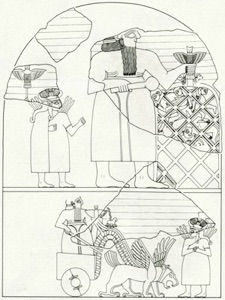
✴in the upper register;
•the large male figure standing at the centre (who holds a mace in his right hand and holds a battle-net full of naked prisoners of war in his left hand) is almost certainly Ningirsu (see below); and
•the small head behind him (and in front of a standard discussed below) belonged to a goddess who had weapons (usually identified as maces) ‘emerging from the shoulders’ was probably Ninhursag or possibly Inanna; and
✴in the lower register:
•the chariot was probably driven by Ningirsu (albeit that only part of his skirt now survives); and
•the small head to the right probably belonged to the same goddess as the one in the upper register.
The important point here is that Eanatum is presumably attributing his success in the campaign depicted on the reverse to the will of the deities depicted on the obverse.
Interestingly, Kish is also referred to on one of the surviving fragments of this stele: we read that, as Eanatum lay sleeping, ‘his beloved king, Ningirsu’ appeared to him in a dream to reassure him that:
“Umma, like Kish, shall therefore wander about, and by means of ones seized by anger(?), shall surely be removed”, (obverse, lines 124’-136’).
This seems to suggest that Kish was allied with Umma at this time, which might explain why (according to the Eanatum Boulder):
✴Kish subsequently ‘trembled before’ Eanatum; and
✴Inanna, who loved him, ‘gave him the kingship of Kish’.
Eanatum and Ningirsu
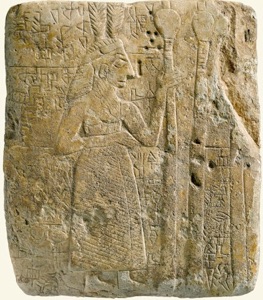
Inscribed stone tablet from Girsu depicting the so-called ‘Figure aux Plumes’ (Figure with Feathers)
Now in the Musée du Louvre (AO 221), image from the museum website
Camille Lecompte (referenced below, at p. observed that this important archaic tablet:
“... consists of two distinct faces:
✴one representing a [a standing figure] equipped with [distinctive] headgear, surrounded by a sort of literary composition is arranged in lines and boxes; and
✴the other that contains only text , which is divided in a more usual way, into columns and boxes”, (my translation).
I must acknowledge that this extract is from is part of a broken passage of the original text and that I have only picked up only the surviving references in it to Ningirsu. However, it seems to me that Eanatum is claiming here that Ningirsu had inseminated his mother in order to create a super-human ruler for Lagash,
In this context, we should also consider another inscription of Eanatum (RIME 1.9.3.10, P431085), which is on a fragmentary vase from Lagash that is now apparently in the Iraq Museum) records Eanatum’s construction of a structure for Ningirsu that he dubbed the E-za (Stone House):
“For the god Ningirsu, warrior of the god Enlil: Eanatum, ensi of Lagash:
✴á-sum-ma (granted power by) Ningirsu;
✴[the one] who restored to Ningirsu his beloved Gu’edena;
✴[the one] who subjugates the lands for Ningirsu;
... built the E-za (Stone House) for the god Ningirsu out of silver and lapis lazuli. He [also] built for him a storehouse, a building of alabaster stone, and amassed piles of grain for him (there). Eanatum:
✴[the one to whom] Ningirsu granted the gidru (sceptre).
His personal god is Sul-MUSHxPA.”
Eanatum and Inanna
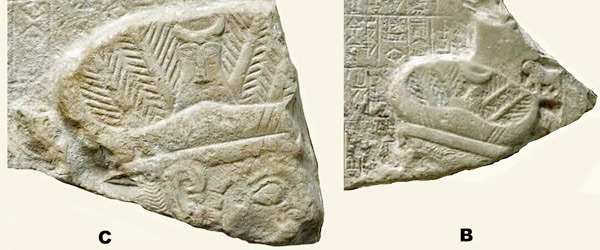
Details of fragments B and C of the ‘Stele of the Vultures’ (illustrated above) showing the head of a goddess
Now in the Musée du Louvre (AO 50): images from the museum website
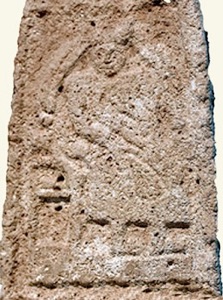
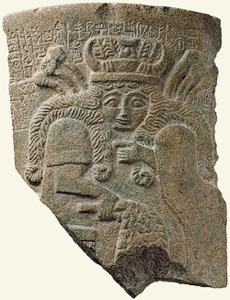
Images of goddess with similar iconography to the goddess on the ‘Stele of the Vultiures’ (above)
Left: Detail of a stele from al-Hiba (Lagash), now in the Iraq Museum (IM 61404): image from Wikimedia
Right: Fragment now in the Staatliche Museen, Berlin (VA 7248): image from website of the Morgan Library
As we have seen, Renate Marian van Dijk-Coombes (referenced below, at p. 201) argued that the goddess depicted in both of the registers on the obverse of the ‘Stele of the Vultures’ (fragments B and C, illustrated above) is probably Ninhursag or possibly Inanna (and she pointed out, at note 8, that she is sometimes identified as Nisaba). The relevant iconographic evidence for this identification is provided by the two other reliefs that are illustrated above:
✴that on one side of an inscribed limestone stele from Lagash that is now in the Iraq Museum (IM 61404), which dates to the reign of Ur-Nanshe, Eanatum’s grandfather; and
✴that on a fragment of an inscribed stone vessel that is now in the Staatliche Museen, Berlin (VA 7248), which almost certainly came from Lagash or Girsu and dates to the reign of Enmetena, Eanatum’s nephew.
Ur-Nanshe is depicted on the other side of the first stele. identified by inscription (RIME 1.9.1. 6a, P431039) as:
“Ur-Nanshe, son of Gu-NI.DU), ensi of Lagash, [the one who] built the Ibgal (= great oval temple of Inanna at Girsu).”
He is accompanied on this face of the by a cup=bearer and, below them, his wife and daughter, all identified by inscription. Most of the other inscriptions on both sides of the stele are now lacunose and largely illegible, although the first line duplicates the inscription identifying Ur-Nanshe as the builder of the Ibgal, which suggests that the enthroned goddess depicted on the opposite side in Inanna. Giovanni Lovisetto (referenced below, at p. 55) observed that she:
“... holds a branch of dates [in her right hand] and possibly a cup, while her extraordinarily long and voluminous hair falls from a (possibly horned) headdress over her shoulders.”
The inscription (RIME 1.9.5. 25, P431142) on the Enmetena vase reads:
“... he [= Enmetena] built E-engur of Zulum for [the goddess Nanshe: he built Abzu-pasira for the god Enki, king of Eridu; [he built the giguna [for] goddess Ninhur[sag]; ... when ... had been granted [presumably by a goddess], he, [Enmetana] set up (this) bur-sag vessel for her.”
Inanna is mentioned in some of the surviving fragments of the inscribed text:
✴as Pirjo Lapinkivi (referenced below, at p. 20) pointed out, Eanatum is referred to as the dam kiag2 (beloved spouse) of Inanna (at reverse, lines 586’-587’); and
✴she is also referred to (at obverse, lines 56’-60’) as:
“Inanna, [who] ... named -Eanatum] as:
‘[the one who is] fitting for the E-anna of Inanna of the Ib-gal (‘great oval’ [temple])”.
This is a reference to a temple excavated at at Lagash that had an outer oval-shaped walled court, which is known from inscribed foundation figurines as the Ibgal of Inanna (see, for example, Paul Collins, referenced below, at p. 105).
It is difficult to know what Eanatum gained from these many and widespread victories recorded in these inscriptions: while we can imagine that they brought him both booty and prestige (and perhaps the right to tribute and military conscripts on an on-going basis), the extent of his political influence over the conquered cities is unclear. As noted above, Aage Westenholz (referenced below, 2020, at pp. 697-8) argued that Eanatum’s victories over cities that were far from Lagash does not prove that he established anything approaching a Sumerian state, centred on Lagash. While this is certainly true, it does seem to me that Eanatum’s claim that:
✴Inanna had given him the kingship of Kish; and
✴Kish had ‘trembled before him’;
does suggest that he had established hegemony over Kish for a period after his victory. Indeed, it is tempting to suggest that sought to present himself as a ‘new Mesalim’. Nevertheless, it seems that any such eminence was short-lived, since nothing in the surviving evidence suggests that any subsequent ruler of Lagash claimed the title ‘king of Kish.
En-anatum I and Enmetena of Lagash
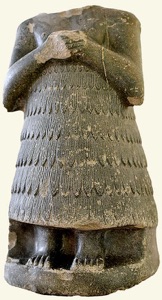
Inscribed statue of Enmetena from Ur (probably not its original location)
Now in the Iraq Museum (exhibit IM 5): image from Wikipedia
Eanatum was succeeded at Lagash by his brother, En-anatum I, followed (probably quite quickly) by his nephew, Enmetena (En-anatum’s son). In an early royal inscription (RIME 1.9.5.1; P431117) of Enmetena, we read that he had repelled successive incursions from Umma. The first was led by Urlumma, ensi of Umma, who:
“... recruited foreigners and transgressed the boundary-channel of Ningirsu:
✴En-anatum, ruler of Lagash, fought with him in the Ugiga-field, the field of Ningirsu; and
✴Enmetena, beloved son of En-anatum, defeated him.
Urlumma retreated to Umma, where he was killed”, (lines 91-108).
However, Umma clearly remained independent, since we read the Il, Urlumma’s successor, asserted that:
“The boundary-channel of Ningirsu and the boundary-channel of Nanshe are mine! I will shift the earth from the boundary moat from Antasura to Edimgalabzu. However, Enlil and Ninhursag did not allow him (to do) this”, (lines 152-64).
While the significance of this last remark is unclear, it seems that the boundary dispute soon resurfaced, albeit that, on this occasion, it was settled without any actual fighting.
Jerrold Cooper (referenced below, at p. 31) observed that:
“Large numbers of clay nails, some foundation tablets, a brick, and a copper peg figurine commemorate Enmetena's building of the [E-mush temple at Badtibira, between Lagash and Uruk]. Of the three different inscriptions represented by these objects, two contain important historical information.”
The first of these historically-important inscriptions (RIME 1.9.5.3, P431119), which has been found on numerous foundation cones from the site of ancient Badtibira, records that:
“For the goddess Inanna and the god Lugal-emush [= Dumuzi]: En-metena, ensi of Lagash, built the E-mush, their beloved temple and ordered (these) clay nails(?) for them. ... At that time, En-metena, ensi of Lagash, and Lugal-kigine-dudu, ensi of Uruk, established a brotherhood (between themselves).”
I will return to the ‘brotherhood’ of Enmetena and Lugal-kigine-dudu below: for the moment, we should merely note that. as Paul Collins (referenced below, at p. 110) observed, while:
“.... Dumuzi was certainly associated with Inanna [at this time] and it is possible that sacred marriage rites between [these two deities, recorded in later sources] developed from a cult at this city. ... there appears to be no evidence ... for the existence of a sacred marriage ritual involving [them] at this time.”
The second of these inscriptions (RIME 1.9.5.4, P431120), which is found, for example, on a tablet that probably came from Girsu (now exhibit AO 24414 in the Musée du Louvre), records Enmetena’s foundation or restoration of a number of religious buildings, including the E-mush temple at Badtibira. Importantly, after this record, we read that:
“He (Enmetena) cancelled obligations for the citizens of Uruk, Larsa and Badtibira. He restored:
✴[the citizens of Uruk] to Inanna's control at Uruk;
✴[the citizens of Larsa] to Utu's control at Larsa; and
✴[the citizens of Badtibira] to Lugal-emush’s control at the Emush (in Badtibira)", (lines 42-55).
As Jerrold Cooper (referenced below, at p. 31) observed:
“This can only mean that Enmetena had [been able to conscript] labourers for his construction of the Emush from Uruk and Larsa (just southwest of Badtibira) as well as from Badtibira itself.”
In other words, the likelihood is that, at least at at the time of his work on the E-mush temple at Badtibira, Enmetena had exercised hegemony over Uruk, Larsa and Badibira (although the circumstances in which he had achieved this status are now unknown).
We should also consider the relationship between Enmetena and Enlil, the main god of Nippur. As we have seen, in the inscription that marked his successes in the ‘traditional’ border dispute with Umma (RIME 1.9.5.1; P431117), he:
✴asserted that the border in question had been demarcated by Enlil, lugal kur-kur-a (king of all lands), ab-ba dingir-dingir-re2-ne-ke4 (father/elder of all the gods) - see lines 1-7; and
✴recorded that, after Eanatum had repelled an incursion across the border by Enakale, ensi of Umma, he had built a shrine to Enlil (and others to Ninhursag, Ningirsu and Utu) on the boundary mound named Namnunda-kigara- see lines 32-66.
Furthermore, as Xianhua Wang (referenced below, at p. 136) pointed out Enmetena repeatedly records in his surviving royal inscriptions that he had built the temple of Eadda (= Temple of the Father), and and, in at least one of them (Ent 1 = RIME 1.9.5.17; P431134), which is on a diorite statue (see below), the link between the Eadda temple and Enlil is explicit:
✴on the right shoulder of the (now head-less) figure, we read that:
“Enmetena, ruler of Lagaš, parcelled out:
•25 bur of land, (a field called) En-ana-tum-sur-Nanshe-etaed;
•11 bur of land, (a field called) Nizuh-shub, in the Abbarnigenak area, next to the Holy Ditch; and
•60 bur of land, (a field called) Enlil in the Gu-edena area;
for Enlil of the Eadda”; and
✴on the back of the figure (col.iii, line 5 - col. iv, line 10), we read that:
“[Enmetena] built é-ad-da im-sag-gá (the Eadda of Imsag) for the god Enlil. At that time, Enmetena created an image of himself, named it ‘Enmetena is the Beloved of Enlil’ and brought it here, int the temple. May Sul-MUSHxPA, the personal god of Enmetena, the builder of the Eadda, forever pray to Enlil for the life of Enmetena.”
This statue was discovered in Ur (which is unlikely to have been its original location) and was exhibited in the Iraq Museum (exhibit IM 5, illustrated above.) The translations above are based on those of Gianni Marchesi (referenced below, 2011, Catalogue 9, at pp, 176-9). As far as we know, Enmetena was the founder of this temple, which was rebuilt four generations later by Urukagina, the last of the ‘Lagash I rulers).
Note Eanatum received the sceptre from Ningirsu
Furthermore, as far as we know, Enmetena was the only ruler of Lagash who made a dedication to Enlil at the Ekur (see, for example, Xianhua Wang (referenced below, Table 3.2.2, at p. 137). This dedicatory inscription (RIME 1.9.5.18; P431135), which is known from surviving fragments of a vase from the site of the Ekur (pace P43135,which gives the find spot as Girsu), records that:
“[When Ningirsu ...] selected (En-metena) from among 36,000 people [usually translated as ‘a myriad/multitude of people’], Enlil granted to En-metena gidri-mah nam-tar-ra (a great sceptre of destiny) from Nippur”, (lines 10’-16’).
This translation is taken from Piotr Steinkeller (referenced below, 2023, note 34, at p. 13): as he set out in this note, the completion of the second word as ‘Ningirsu’ is based on similar passages in the royal inscriptions of other rulers of Lagash, including Urukagina (see below). Unfortunately, almost all of the opening dedicatory text on this vase is now lost:
✴The vase must have been dedicated to Enlil, and we might have expected that Enlil would have been given the epithet ‘king of all lands here (as he was in the inscription above).
✴However, Xianhua Wang (referenced below, at pp. 136-7, who labelled this inscription Ent 32) argued that the most likely completion of the surviving text is dEnlil, é-ad-da-ka-ra (Enlil of the Eadda): see also Douglas Frayne (referenced below, 2008, at p. 222).
It is therefore hard to escape the conclusion that Enmetena’s dedication at the Ekur at Nippur was in some way related to his foundation of the Eadda at Lagash.
More importantly for our current analysis, in a single inscription in Wang’s Table 3.1.1 (Ent 28-9 = RIME 1.9.5.1; P431117), Enmetena is described as:
“... gidru-sum-ma-dEnlil ([the one who was] granted the sceptre by the god Enlil )... “, (lines 183-7).
Wang argued (at pp. 131-2) that:
“The Sumerian word gidru in [this epithet] ... must symbolically fall into the semantic field of ‘á’ in the epithet ‘á-sum-ma-dEnlil‘, which must [therefore] mean generally the ‘ruling power’.”
However, he also argued that these epithets must be differentiated, because:
✴both Ningirsu and Enlil could grant this ‘ruling power’; but
✴only Enlil could grant the gidru (sceptre) of Nippur.
[the territories of the] gods:
✴Ningirsu, [patron of Lagash]; and
✴Shara, [patron of Umma”, (lines 1-7).
In other words, it is possible that Enmetena claimed that Enlil had granted him the sceptre of Nippur in recognition of his success in redressing the sacrilege committed by the ensi of Umma.
We might also reasonably assume that Enmetena made the dedication at Nippur in person. Indeed, as Xianhua Wang ( referenced below, at p. 132) suggested:
“The use of gidru in the title only of Entemena was probably the result of the expansion of [his] power to Nippur, where he might have had participated in some rite metaphorically receiving the gidru of Enlil.”
What is less clear is the precise significance of Enmetena’s receipt of the sceptre of Nippur. It seems to me to be significant that, although Enmetena credited Enlil, lugal kur-kur-a (king of all lands), ab-ba dingir-dingir-re2-ne-ke4 (father/elder of all the gods) with the demarcation of the boundary between Lagash and Umma, he apparently made his dedication at the Ekur to dEnlil, é-ad-da-ka-ra (Enlil of the Eadda)
Abbreviations
EKI = Friedrich König (referenced below)
MDP 11 = Jean-Vincent Scheil (referenced below)
RIME 1 = Douglas Frayne (referenced below, 2008)
RIME 2 = Douglas Frayne (referenced below, 1993)
Other references:
Steinkeller P., “Urukagina’s Rise to Power”, in:
Cohen Y. et al. (editors), “Drought will Drive You Even Toward Your Foe”, (2023) Leiden and Boston, at pp. 3-36
Lovisetto G., “Goddesses Visualized in Early Dynastic Mesopotamia”, in:
Babcock S. and Tamur E. (editors), “She Who Wrote: Enheduanna and Women of Mesopotamia, ca. 3400–2000 BC”, (2022) New York, at pp. 46-63
Steinkeller P., ‘The Sargonic and Ur III Empires’, in:
Bang P. F. et al. (editors), “The Oxford World History of Empire (Volume 2): The History of Empires”, (2021) New York, at pp. 43-72
Lecompte C., “A Propos de Deux Monuments Figurés du Début du 3e Millénaire : Observations sur la ‘Figure aux Plumes’ et l’a Prisoner Plaque’”, in:
Arkhipov A. et al. (editors), “Studies in Early Mesopotamia and Syria in Honor of Walter Sommerfeld and Manfred Krebernik”, (2020), Leiden and Boston, at pp. 417-46
Westenholz A., “Was Kish the Center of a Territorial State in the Third Millennium?—and Other Thorny Questions”, in:
Arkhipov I. et al. (editors), “The Third Millennium: Studies in Early Mesopotamia and Syria in Honor of Walter Sommerfeld and Manfred Krebernik”, (2020) Leiden and Boston, at pp. 686-715
van Dijk-Coombes R. M., “Lions and Winged Things: A Proposed Reconstruction of the Object on the Right of the Lower Register of the Mythological Side of Eanatum's Stele of the Vultures”, Die Welt des Orients, 47:2 (2017) 198-215
Marchesi G., “The Inscriptions on Royal Statues (Chapter 4)”, in
Marchesi G. and Marchetti N. (editors), “Royal Statuary of Early Dynastic Mesopotamia”, (2011) Winona Lake, IN, at pp. 155-86
Wang X., ”The Metamorphosis of Enlil in Early Mesopotamia”, (2011) Münster
Frayne D. R., “The Royal Inscriptions of Mesopotamia, Vol. 1: Presargonic Period (2700-2350 BC)”, (2008) Toronto
Lapinkivi P., “The Sumerian Sacred Marriage and Its Aftermath in Later Sources”, in:
Nissinen M. and Uro R. (editors), “Sacred Marriages: The Divine-Human Sexual Metaphor from Sumer to Early Christianity”, (2008) University Park, PA, at pp. 7-42
Steinkeller P., “An Ur III Manuscript of the Sumerian King List”, in:
Sallaberger W. et al. (editors), “Literatur, Politik und Recht in Mesopotamien: Festschrift fur Claus Wilcke”, (2003) Wiesbaden, at pp. 267-92
Collins P., “The Sumerian Goddess Inanna (3400-2200 BC)”, Papers from the Institute of Archaeology, 5 (1994) 103-18
Frayne D. R., “Sargonic and Gutian Periods (2334–2113 BC): The Royal Inscriptions of Mesopotamia. Early Periods (Volume 2)”, (1993) Toronto, Buffalo and London
Nigro L., “The Two Steles of Sargon: Iconology and Visual Propaganda at the Beginning of Royal Akkadian Relief", Iraq, (1998) 85-102
Winter I, J., “After the Battle Is Over: The ‘Stele of the Vultures’ and the Beginning of Historical Narrative in the Art of the Ancient Near East”, Studies in the History of Art, 16 (1985) 11-32
Cooper, J. S., “Reconstructing History from Ancient Inscriptions: The Lagash-Umma Border Conflict”, (1983), Malibu CA